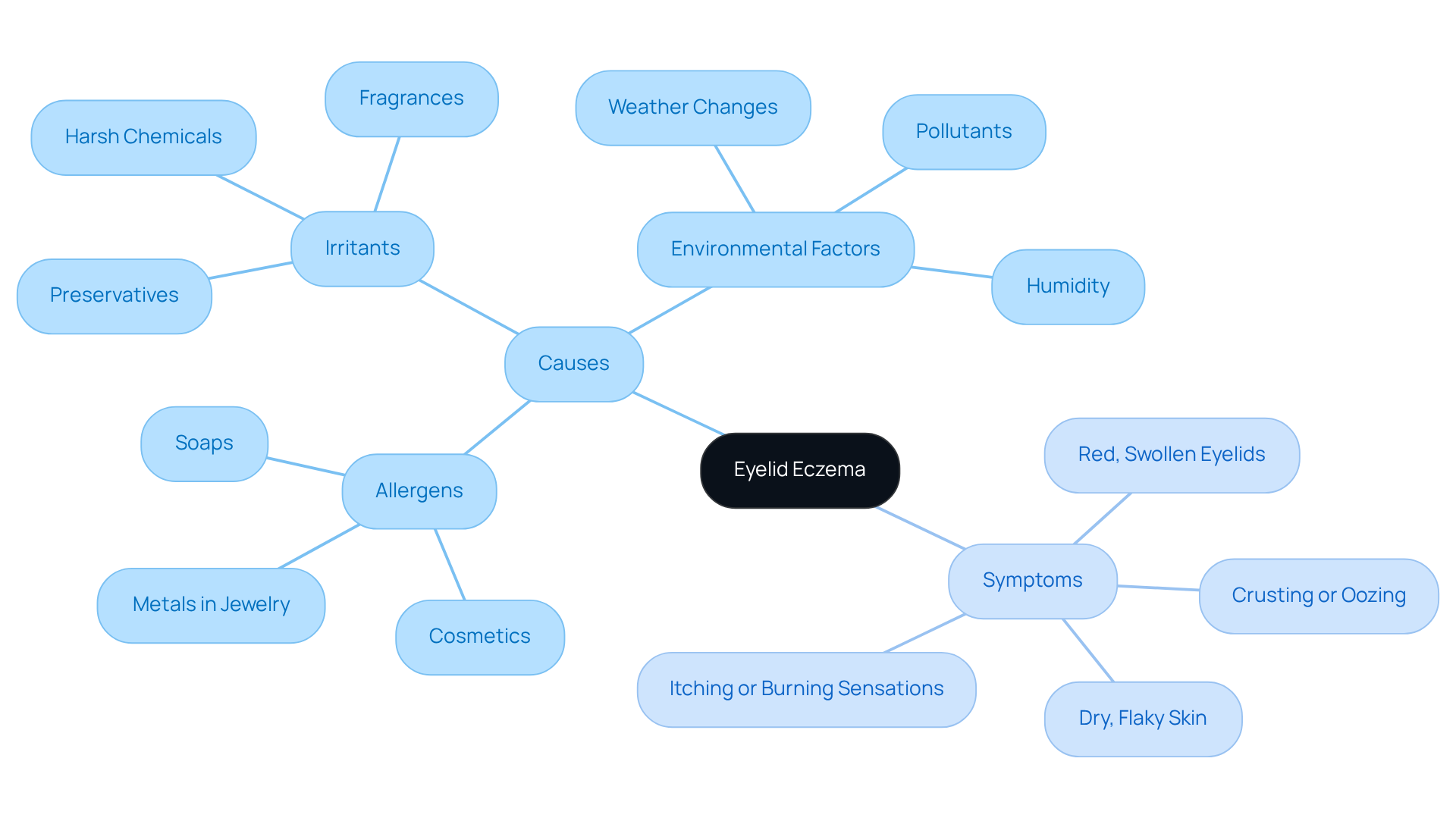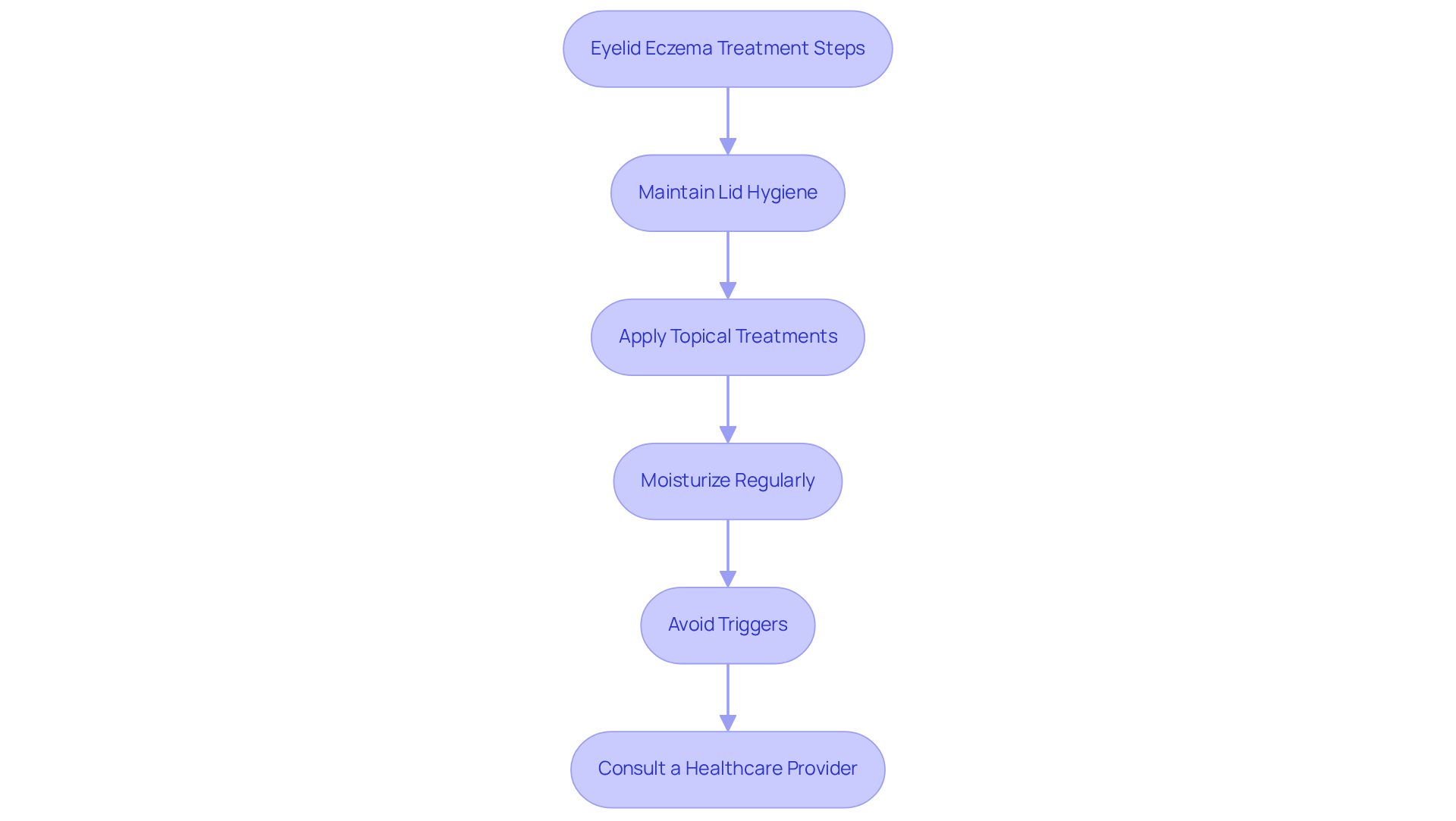Posted by: Northwest Eye in General on June 22, 2025
Overview
Managing eyelid eczema can feel overwhelming, but with a compassionate three-step approach, you can find relief.
- First, it’s essential to maintain lid hygiene.
- Next, applying appropriate topical treatments is crucial.
- Finally, regular moisturizing can make a significant difference.
We understand that avoiding triggers and consulting healthcare providers may seem daunting, but these steps can significantly alleviate symptoms and improve your overall quality of life.
Remember, you are not alone in this journey, and we are here to help you through the process.
Introduction
Eyelid eczema, often overlooked, can significantly impact daily life with its uncomfortable symptoms like redness, itching, and swelling. We understand how distressing this condition can be.
Recognizing the triggers—ranging from allergens in cosmetics to environmental irritants—is crucial for effective management. This article offers a comprehensive guide on how to alleviate discomfort and prevent flare-ups through practical steps and long-term care strategies.
What if the key to reclaiming comfort lies in recognizing these triggers and adopting a proactive approach? We are here to help you through this process.
Understand Eyelid Eczema: Causes and Symptoms
Eyelid eczema, which is also referred to as eyelid dermatitis, is a prevalent condition that can cause inflammation, redness, and itching of the eyelids. We understand how distressing this can be, and it’s important to recognize that various factors can trigger this condition, including:
- Allergens: Everyday items like cosmetics, soaps, and certain metals in jewelry can provoke reactions.
- Irritants: Products containing fragrances, preservatives, or harsh chemicals often irritate the delicate skin around your eyes.
- Environmental Factors: Changes in weather, humidity, and exposure to pollutants can worsen your symptoms.
Symptoms of eyelid eczema typically include:
- Red, swollen eyelids
- Itching or burning sensations
- Dry, flaky skin
- Crusting or oozing in more severe cases
It’s common to feel overwhelmed by these symptoms, but early recognition is crucial for seeking the right treatment and preventing further irritation. Research indicates that approximately 15% of individuals with atopic dermatitis experience involvement of the eyes, highlighting the importance of awareness and proactive management. By identifying and avoiding common allergens and irritants, you can significantly reduce flare-ups and improve your quality of life. Remember, we are here to help you through this process.

Follow Treatment Steps for Eyelid Eczema Relief
To effectively manage eyelid eczema, we recognize that dealing with it can be a frustrating experience. Here are some compassionate steps to guide you through the treatment process:
-
Maintain Lid Hygiene:
- Begin by applying a warm compress to your eyelids for 5-10 minutes. This will help soften crusts and unblock oil glands.
- Gently massage the margins of your eyes with clean fingers. This promotes drainage and lessens irritation, making you feel more comfortable.
-
Apply Topical Treatments:
- Consider using a mild topical corticosteroid cream, such as hydrocortisone 0.5% or 1%, as prescribed by your healthcare provider. This can alleviate inflammation and provide relief.
- For sensitive areas, non-steroidal alternatives like tacrolimus or pimecrolimus are often preferred due to their favorable safety profiles.
- It’s important to note that hydrocortisone 1% is not the preferred therapy for eyelid eczema, as it may lead to considerable side effects on this delicate tissue.
-
Moisturize Regularly:
- Apply a fragrance-free moisturizer to your eyelids twice daily to maintain hydration. Look for products specifically formulated for sensitive skin to avoid irritation and keep your skin feeling soft.
-
Avoid Triggers:
- Identify and steer clear of known allergens or irritants, such as certain cosmetics or skincare products.
- Whenever possible, opt for hypoallergenic products to minimize flare-ups and help your skin feel more at ease.
-
Consult a Healthcare Provider:
- If your symptoms persist or worsen, we encourage you to seek advice from a dermatologist or ophthalmologist for further evaluation and .
- Regular follow-ups can help assess treatment effectiveness and adjust strategies as needed, ensuring you receive the best care possible.
Statistics suggest that topical corticosteroids have a high success rate in managing skin conditions, with response rates ranging from 39% to 75% compared to placebo. Experts emphasize the importance of utilizing the least powerful corticosteroid necessary to manage symptoms, especially on delicate regions like the eyelids. By following these steps, you can effectively manage eyelid eczema and enhance your quality of life. Remember, we are here to help you through this process.

Maintain Eye Health: Long-Term Care Strategies
To maintain and prevent future occurrences of eyelid eczema, we recognize that implementing long-term care strategies can be advantageous. Here are some thoughtful suggestions:
- Regular Eye Exams: Schedule routine check-ups with your ophthalmologist. We know that regular eye exams are crucial, as studies show that many adults at high risk for vision loss often neglect these visits. In fact, only 56.9% had seen professional annually in 2017. Early detection of issues can significantly impact treatment outcomes, providing you with reassurance and support.
- Use Gentle Products: Choose fragrance-free and hypoallergenic skincare and makeup products. It’s common to feel overwhelmed by the variety of options, so steering clear of recognized triggers can help reduce the chance of worsening skin condition signs.
- Manage Stress: We recognize that stress can worsen eczema symptoms. Incorporating stress-reducing activities such as yoga, meditation, or regular exercise into your routine can help you manage your overall complexion health and promote a sense of well-being.
- Stay Hydrated: Drink plenty of water to keep your skin hydrated from the inside out. Staying hydrated is essential for maintaining skin barrier function, which can alleviate discomfort.
- Educate Yourself: Utilize Northwest Eye’s Eye Condition Library to gain a deeper understanding of eyelid eczema management, as well as other conditions like dry eye and glaucoma. This resource empowers you to take an active role in your eye health, fostering confidence in your decisions.
Implementing these strategies can help maintain your eye health and reduce the likelihood of future flare-ups. Remember, we are here to support you in proactively managing eyelid eczema.
Conclusion
Eyelid eczema can be a challenging condition to navigate, and we understand how it can affect your daily life. By recognizing its causes, symptoms, and effective management strategies, you can significantly improve your quality of life. Implementing a comprehensive treatment plan tailored to your needs can bring relief from discomfort and help you maintain healthy eyelids.
Key steps to manage eyelid eczema include:
- Maintaining lid hygiene
- Applying appropriate topical treatments
- Moisturizing regularly
- Avoiding known irritants
Additionally, consulting a healthcare provider ensures you receive tailored care and ongoing support. Long-term strategies, such as using gentle products, managing stress, and staying hydrated, further contribute to preventing flare-ups and promoting overall eye health.
Taking proactive measures is essential in managing eyelid eczema effectively. By prioritizing your eye health and utilizing the available resources and strategies, you can empower yourself to face this condition with confidence and resilience. Embrace these steps to enhance your well-being and enjoy clearer, healthier eyelids. Remember, we are here to help you through this process.
Frequently Asked Questions
What is eyelid eczema?
Eyelid eczema, also known as eyelid dermatitis, is a common condition characterized by inflammation, redness, and itching of the eyelids.
What are the common causes of eyelid eczema?
Common causes include allergens such as cosmetics, soaps, and certain metals in jewelry; irritants found in products with fragrances, preservatives, or harsh chemicals; and environmental factors like weather changes, humidity, and exposure to pollutants.
What are the typical symptoms of eyelid eczema?
Symptoms typically include red, swollen eyelids, itching or burning sensations, dry, flaky skin, and in more severe cases, crusting or oozing.
How prevalent is eyelid eczema among individuals with atopic dermatitis?
Research indicates that approximately 15% of individuals with atopic dermatitis experience involvement of the eyes.
Why is early recognition of eyelid eczema important?
Early recognition is crucial for seeking the right treatment and preventing further irritation. Identifying and avoiding common allergens and irritants can significantly reduce flare-ups and improve quality of life.






